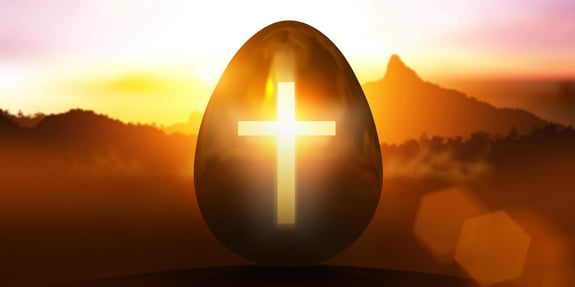Everyone knows that Easter egg coloring and the traditional Easter egg hunt are activities tied to the celebration of the Easter story. Easter is a biblical holiday that celebrates Jesus’ resurrection after being crucified on the cross.
Each year, individuals and families gather to celebrate Jesus’ rising from the dead. From church services to religious activities, the commemorations are plentiful. Easter egg decorating is just one such activity people do generally before the holiday unfolds.
BECOME AN INSIDER: Get faith and entertainment news straight to your inbox!
But, why? Why do we celebrate with the traditional Easter egg hunt and Easter egg coloring? Where did the tradition actually come from? Is it based on Scripture or is it just a modern-day secular practice that people engage in for the mere fun of it? That’s what we’ll be exploring in this piece.
The Origin of Easter Eggs
To begin, eggs themselves tend to signify life. And Jesus’ rise from the dead clearly gives mankind eternal life, so the parallels shouldn’t be lost on us.
It might be hard to definitively nail down the history of Easter egg decorations, but we can surely see the use of eggs more generally throughout history during the time of Easter. As it turns out, Easter eggs actually date back to Medieval Europe, though the practice of celebrating with these eggs might not have started with Christians and might have instead been a Pagan practice, according to Time.
There are different theories about the origin of Easter eggs, but Carole Levin, professor of history and director of the Medieval and Renaissance Studies Program at the University of Nebraska, told the outlet that eggs were part of an Anglo-Saxon festival that celebrated the goddess Eastre.
READ ALSO: 5 Powerful Bible Verses About Jesus’ Resurrection And Easter
This celebration commemorated the coming of spring and the coming back of nature after winter, and eggs were eaten and “also possibly buried in the ground to encourage fertility,” Levin said.
Lubow Wolynetz, curator of folk art at the Ukrainian Museum in New York City and the Ukrainian Museum and Library in Stamford, Connecticut, told Country Living a bit more about the role of eggs in pre-Christian cultures.
“In pre-Christian days, eggs were associated with many different springtime rites,” Wolynetz said. “In Ukraine, for example, people were an agricultural society. A late or cold spring had an impact on crops, so people attempted to harness the power of the sun to bring about the resurrection of nature.”

Wolynetz said that people were reminded of the sun due to the yellow center of eggs — and that early Ukranians would decorate the outside of eggs and then give them to family members and friends.
Later, when Christianity arrived in Ukraine in the 10th century, old and new traditions collided, according to Country Living.
DOWNLOAD OUR FREE "RISEN" DISCUSSION GUIDE – OUR EASTER GIFT TO YOU!
The History of Why We Dye Easter Eggs
As for specific Easter egg decorating, Britannica noted that the first instance of painted Easter eggs dates back to the 13th century. The tradition in Orthodox and Eastern churches is that early Christians would paint the eggs red to symbolize the blood of Christ that was shed on the Cross.
According to Good Housekeeping, early Christian missionaries dyed the eggs different colors to represent different aspects of the Easter story. Yellow was used to represent the resurrection, blue to represent love and red again was used to represent the blood of Christ.
Why Do We Hunt for Easter Eggs?
There are two main theories that date the history of Easter egg hunts. One theory says this tradition dates back to the Pennsylvania Dutch of the 1700s. They believed in a hare called 'Oschter Haws' would laid eggs in the grass. Children would build nests for it to lay in — then search for the eggs it left behind. Oschter Haws eventually became the Easter Bunny, who isn't known for its egg-laying capabilities, but the tradition of searching for his 'presents' stuck around.
Easter egg hunts can be traced back to Martin Luther, a key leader in the Protestant reformation. Men would hide eggs for women and children to find. It is believed that the joy the women and children experienced as they found eggs is meant to mimic the joy Mary Magdalene and the Apostles felt when they found Jesus’ tomb empty and realized He had risen.
So, Are Easter Eggs Pagan?
Answers in Genesis has also tackled this topic as well, explaining that the bunnies, Easter eggs and other elements that have become staples of the Easter holiday certainly have Pagan roots.
“There is no question that a majority of these practices have their origins in pagan customs,” AiG noted. “These customs were assimilated into Christian practices throughout the early centuries of the church.”
READ ALSO: 6 Movies And TV Shows To Inspire Kids This Easter
The Christian outlet noted that eggs have long been “a symbol of fertility cults and pagan rituals around the world.” And Easter egg coloring might also have its roots in these practices as well, as there is no biblical example or command surrounding the coloring of eggs, especially as it pertains to celebrating Jesus’ rise from the dead.
Considering the fact that Easter egg coloring, Easter egg decorations and the traditional Easter egg hunt could all have its original history wedded to Paganism, AiG asked an important question: “If an object or action is used in pagan worship, can it ever be used to worship God?”
In the end, the outlet concluded that people will take different positions. Either way, Easter eggs are used by many Christians to celebrate Christ’s resurrection and are in no way used in Pagan practice.
And the ways in which Christians and others use and decorate the Easter egg are certainly different from the ways in which eggs were handled by Pagans.
So, it’s up to the conviction of each Christian to decide how to — or even whether — to engage in Easter egg coloring, the traditional Easter egg hunt, etc.
READ ALSO: 9 Easter Movies and Shows You Can Stream Right Now
As it turns out, Christians didn’t allow eggs to be eaten during Holy Week, so eggs were held and then decorated to commemorate Easter. Regardless of how the Easter tradition began, Christians began to use it to celebrate the resurrection.
And if you do an Easter egg hunt, consider hiding Bible verses in the eggs along with candy. There are also fun-filled kits available that tell the Easter story through plastic Easter eggs — kits you can use with the whole family.
Rise Above this Easter and experience the difference that wholesome entertainment can have in your home with clean streaming from Pure Flix. Become a Pure Flix member and start streaming authentic faith and family-friendly movies and shows for the whole family like “The Messiah: A Brickfilm,” “The Chosen.” You’ll also find varying perspectives on the crucifixion of Jesus with movies like “Risen,” "The Passion of the Christ" and “The Penitent Thief.”



COMMENTS